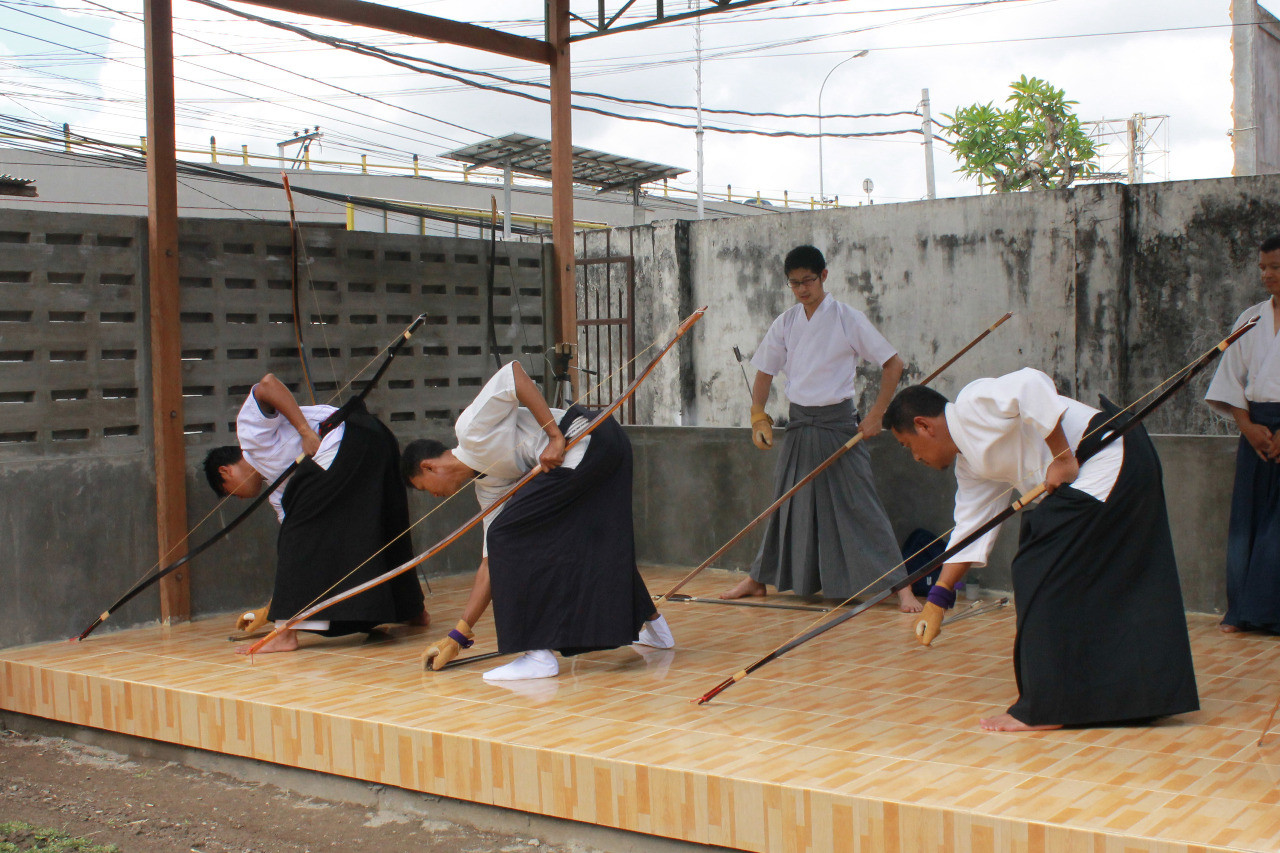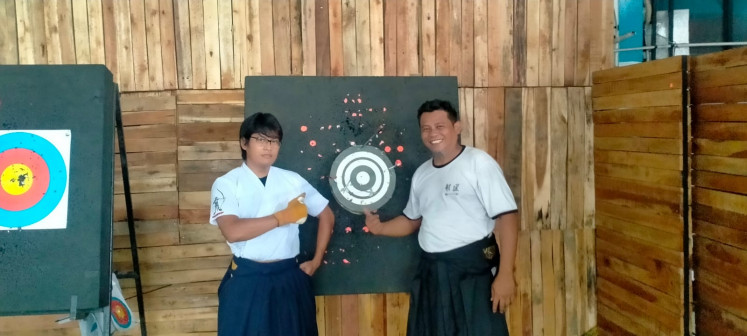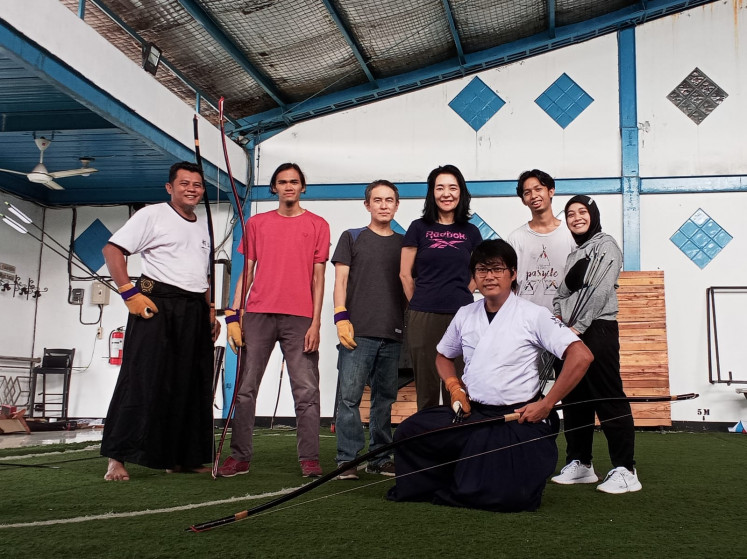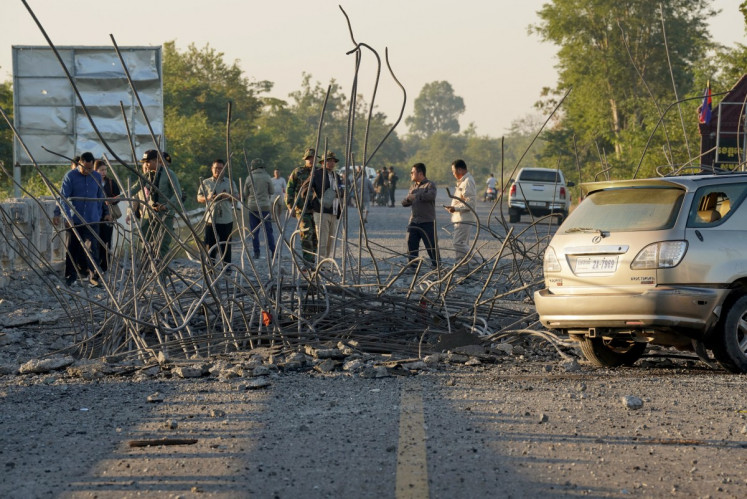Popular Reads
Top Results
Can't find what you're looking for?
View all search resultsPopular Reads
Top Results
Can't find what you're looking for?
View all search resultsIndonesian samurai?: Practicing Japanese military archery with Heki Ryu Indonesia
Change text size
Gift Premium Articles
to Anyone
A
ccording to Muyedobotongji, a martial arts manual from ancient Korea: the Chinese have perfected their spears, the Koreans their bows and arrows and the Japanese their swords. Little did many know, however, that bows and arrows were the primary weapons of the samurai.
Archery has been with humanity since antiquity. Bows and arrows accompanied men in warfare and hunting throughout history, winning them decisive battles and earning them resources. There are many ways of shooting the bow, from the fast-paced shooting one commonly sees in Turkey to the slow and ceremonial schools of Japanese archery.
Heki-ryu is a school within kyudo. Kyudo refers to traditional archery as practiced in Japan. Literally, the term means “the way of the bow”. As opposed to mainstream kyudo, which in modern day represents Japanese archery culture in general, Heki-ryu is not focused on the ceremonial aspect of the art. Rather, it focuses on the martial side of archery, apparent from its emphasis on battlefield-oriented technique.
Developed by Heki Danjo Masatsugu during the Ashikaga period of Japan, which overlaps with the Sengoku (Warring States) period when Japanese daimyo (feudal lords) waged war with each other, Heki-ryu found its way to Indonesia by means of Tamatsugu Goka, who taught the style to the founders of Heki Ryu Indonesia - Adam Numair Nusantara, Yoeru Sadewa and Agus Hermawan.
"I have been practicing archery since 2015 but was exposed to kyudo in 2018," Numair, who is also a bower, said. "When I visited Japan, I asked my peers to recommend an archery school to me. They told me to meet Makinori Matsuo, a professor of kyudo at the University of Tsukuba. It occurred that the style practiced by his dojo was Heki-ryu."
"He taught me the basics of kyudo, namely the eight steps. Then he recommended a shop, from which I then bought a yumi."
Yumi is the Japanese word for the bow. However, outside of Japan, yumi refers only to Japanese bows. Numair brought the bow home to Bandung, West Java, and began practicing by himself. That is, until Goka, a junior of Matsuo, came to Yogyakarta, Central Java, to pass down the art to Numair, Yoeru and Agus and formally take them as pupils. Heki Ryu Indonesia, according to Numair, is now an official branch of Heki-ryu.
While Numair said he "fell in love with kyudo" because the community was "very welcoming" to him, Angking, who prefers to only share his nickname, said he was interested in learning Heki-ryu because it has clear directions.
"I hate it when I ask a teacher or instructor, and he answers with 'Just do as I say'," Angking, who has been an archer since 2017, said.
In Heki-ryu, he added, one will not hear such an answer as there is always an explanation of why the archers must do what they do. Its clear history is also what draws him to the school. "It has a clear lineage; the technique can be traced back to its founder," the Bekasi, West Java, native continued.
Angking was the one who suggested the idea of looking for a kyudo instructor to Numair. That being said, he refused to be referred to as an initiator of Heki Ryu Indonesia.
"I am just someone who practices and discusses archery with kang [brother] Numair. Nothing more, nothing less," he explained.
Give it a try: Numair (left) and Angking both practice other archery styles, including Chinese archery. (Courtesy of Heki Ryu Indonesia) (Courtesy of Heki Ryu Indonesia/Courtesy of Heki Ryu Indonesia)Heki-ryu vs. mainstream Japanese archery
The distinguishing feature separating Japanese archery from its neighbors is its two-meter long composite bow, which allows for a longer draw stroke, with arrows measuring over 90 cm in length. Additionally, despite being shot with the thumb draw, as in most other major Eurasiatic archery cultures, kyudo archers do not use a thumb ring but rather a special glove called the yugake. While this is also true for Heki-ryu, what makes the style different from mainstream kyudo is, then, its approach to archery.
"The term kyudo is often used to refer to traditional archery as practiced in Japan. However, in the strictest sense, kyudo refers to the modern, formalized way of using the Japanese bow," Numair explained. "This is the form of shooting that people associate most with Japanese archery.
"In Heki-ryu, in addition to learning how to shoot in this formal, spiritually-oriented style, we also learn how to shoot the bow in the most traditional way. This includes the koshiya kumiyumi, where we shoot wearing full-pledged armor. Here, we do not lose our arrows slowly [as in mainstream kyudo]. Rather, we shoot as if we are on a battlefield. It is essentially a battle simulation," Numari added.
"In addition to shooting fast, we also use quivers," Angking added. "Unlike the standardized kyudo, there is nothing meditative about Heki-ryu."
Numair elaborated on why Heki-ryu might also be different from other Japanese battlefield-oriented archery. "Heki Danjo Masatsugu created the technique for infantrymen," he said. "Therefore, Heki-ryu is strictly an on-foot archery style. The other battlefield-oriented styles shoot from the horseback as the samurai needed to counter indigenous peoples in the north, who were themselves mounted archers."
Numair then went on to explain that Heki-ryu also incorporates flight shooting, a category where archers launch their arrows into the sky in the hope that they cover as much distance as possible. This is not found in kyudo.
"Heki-ryu is rooted in military traditions," Numair continued. "However, many of its military aspects have also been watered down by the 250 years of peace that came after the Sengoku period. Japan had to face modernization, which resulted in cold weapons losing popularity to modern firearms."
Numair explained that this is also what led Japanese archery to evolve into its current slow-paced, ceremonial and ritualistic form, where the sequence of the technique does not start when the archer nocks his arrow and does not stop when he releases it. Instead, it starts and stops from the moment the archer enters the room and exits it.
There are directions on how to enter the shooting room properly, sit, bow at the makiwara (hay target) and exit the room after one finishes. This is also true for Heki-ryu, as its archers also have to master the standard kyudo form.
One aspect of military archery that can no longer be found in Heki-ryu, however, according to Numair, is the emphasis on training to shoot with strong bows. "This is because the distance to the target has been standardized to 28 meters," he said. "This standardization led to the decrease in demand for heavy bows and the increase for low-poundage bows. It is like, 'Why would I need to shoot a high-poundage bow to shoot 28 meters?'
"This made me realize that there have to be many aspects of the technique that have been lost, especially on how to shoot a heavy bow and shoot from great distances. When you look at ancient paintings, the anchor point is lower. That could be the answer."
Strike a pose: Members of Heki Ryu Indonesia are pictured with their two-meter long 'yumi' after a practice session at their temporary dojo in Buaran, Jakarta. (Courtesy of Heki Ryu Indonesia) (Courtesy of Heki Ryu Indonesia/Courtesy of Heki Ryu Indonesia)Responses from Indonesian archery communities
Angking said Heki Ryu Indonesia received mainly positive responses from other traditional archers in Indonesia.
"People are curious mainly about why one must shoot with such a long and cumbersome bow," he said. "I've brought my yumi to many cities in Indonesia. Those who tried shooting my yumi said they loved it.
"However, as one saying goes, 'you need to get to know something so you can love it'. Therefore, those interested in joining Heki Ryu Indonesia can contact kyudo associations in Jakarta, Bandung, and Bali," he continued.
"Those who are in Bandung can also get in touch with kang Numair. We are currently renting a building that we use as a temporary dojo in Buaran, but we are also in the process of building a permanent one in Pamulang, Banten. You can just pop up should you want to train with us. Then, those whose city or region is out of reach can join us in our online learning program."
ohmg













